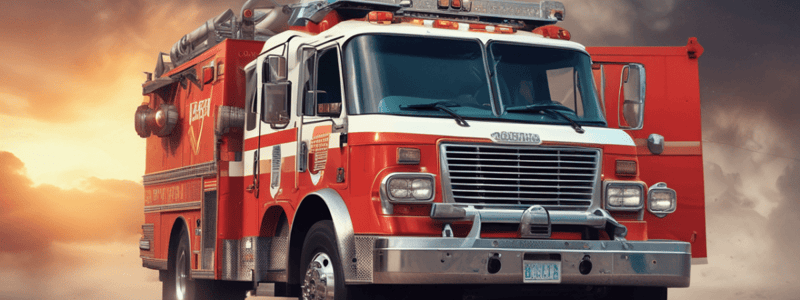Podcast
Questions and Answers
What is the primary role of a responder in a rescue scenario?
What is the primary role of a responder in a rescue scenario?
- To call for extrication equipment and specialized crews only
- To remove patients from entrapment or dangerous situations without proper training
- To provide emergency medical care and perform extrication techniques
- To provide emergency medical care and prevent further injury, while also providing simple extrication when tools are not required (correct)
What is the importance of situational awareness in rescue scenarios?
What is the importance of situational awareness in rescue scenarios?
- To evaluate hazards and determine the number of patients and vehicles involved
- To call for extrication equipment and specialized crews
- To recognize potential threats and react proactively (correct)
- To provide emergency medical care only
What is the first step a responder should take when arriving at a rescue scene?
What is the first step a responder should take when arriving at a rescue scene?
- Provide emergency medical care immediately
- Call for extrication equipment and specialized crews
- Remove patients from entrapment or dangerous situations
- Conduct a 360-degree walk-around to evaluate hazards (correct)
What is the purpose of pre-incident training in the extrication process?
What is the purpose of pre-incident training in the extrication process?
Why is it necessary to wear blood and fluid impermeable gloves during a rescue scenario?
Why is it necessary to wear blood and fluid impermeable gloves during a rescue scenario?
How many phases are there in the extrication process?
How many phases are there in the extrication process?
What is the primary responsibility of law enforcement at a vehicle crash scene?
What is the primary responsibility of law enforcement at a vehicle crash scene?
What should you do if you encounter downed power lines at a vehicle crash scene?
What should you do if you encounter downed power lines at a vehicle crash scene?
Why should you approach a damaged vehicle from the side?
Why should you approach a damaged vehicle from the side?
What is a critical consideration when working with alternative fuel vehicles?
What is a critical consideration when working with alternative fuel vehicles?
Who should be in charge of the move when extricating a patient from a vehicle?
Who should be in charge of the move when extricating a patient from a vehicle?
What should you prioritize when determining the need for rapid vehicle extrication?
What should you prioritize when determining the need for rapid vehicle extrication?
What is the primary role of EMS providers in tactical rescue situations?
What is the primary role of EMS providers in tactical rescue situations?
What is a critical consideration in trench rescue situations?
What is a critical consideration in trench rescue situations?
Where should response vehicles park at a trench rescue scene?
Where should response vehicles park at a trench rescue scene?
What is the purpose of dispatching an ambulance with fire apparatus to a structure fire?
What is the purpose of dispatching an ambulance with fire apparatus to a structure fire?
Flashcards are hidden until you start studying
Study Notes
- Vehicle extrication, special rescue, and hazardous materials rescue require training beyond the advanced emergency medical technician (EMT) level and involve multiple processes and environments.
- Initial actions in a rescue scenario may determine the efficiency of the rescue, but this training is not sufficient to certify individuals to perform extrications or rescues.
- Extrication requires mental and physical preparation, and the removal of a patient from entrapment or a dangerous situation is very stressful.
- Wear blood and fluid impermeable gloves at all times during contact, and wear leather gloves over disposable gloves during extrication for safety.
- The primary role is to provide emergency medical care and prevent further injury, while also providing simple extrication when tools are not required.
- There are 10 phases to the extrication process, including preparation, which involves pre-incident training and routine checks of extrication tools and response vehicles.
- Situational awareness is key in these types of scenes, recognizing and understanding potential threats and reacting proactively.
- The first responder on the scene may need to call for extrication equipment, fire service personnel, law enforcement, and specialized crews.
- Conduct a 360-degree walk-around to evaluate hazards, consider potential injuries, and determine the number of patients and vehicles involved.
- Note any physical changes to the vehicle structure, such as deformities to the steering wheel or dashboard, and shattered windshields.
- Report to the Incident Commander upon arrival, coordinating efforts with the rescue team and law enforcement.
- The rescue team is responsible for stabilizing the vehicle, protecting the scene, and providing safe entrance and access to patients.
- Law enforcement is responsible for traffic control, direction, and maintaining order, while firefighters are responsible for extinguishing fires, preventing additional ignition, and ensuring scene safety.
- Downed power lines are a common hazard at vehicle crashes; never attempt to move them, and instruct patients to remain in their vehicles until the power is shut off.
- Vehicles themselves can be hazards, so ensure the car is in park with the parking brake set and the ignition turned off, and disconnect the battery if necessary.
- Vehicle safety systems, such as shock-absorbing bumpers and airbags, can also become hazards, so approach vehicles from the side and use caution when working in damaged vehicles.
- Alternative fuel vehicles require special precautions, such as proper PPE and avoiding unusual odors or burning sensations.
- Trained responders need to be able to disable high-voltage battery packs and may need to mark helicopter landing zones.
- Consider the patient's position, injuries, and severity when determining the need for rapid vehicle extrication.
- Communicate with the patient, describing actions before performing them, and prioritize patient safety during extrication.
- Provide emergency medical care as needed, performing primary surveys and assessments before further extrication.
- Good communication and clear leadership are essential in an extrication or rescue effort, with one member clearly in charge.
- Upon removal of the patient, rapidly assess other patients previously inaccessible and perform a complete primary assessment.
- Ensure sufficient personnel to perform the move, and one person should be in charge of the move to minimize further injury.
- Choose the path that requires the least manipulation of the patient or equipment, and continue with assessment and treatment once the patient is on the stretcher.
- Upon termination, return emergency units to service, check equipment, and complete necessary reports.
- Specialized teams, such as SWAT Medics, mountain rock ice climbing rescue, and water and small craft rescue, may be required depending on the area and situation.
- In tactical rescue situations, be aware of potential danger and let trained personnel handle the situation, while preparing to perform primary assessment and treatment once the patient is extricated.
- Tactical situations involve hostages, robberies, or other situations where armed conflict occurs, requiring specialized law enforcement tactical units.
- EMS providers must prepare, plan, and train for these incidents, knowing how to stay safe and taking direction from law enforcement personnel.
- Document any requests or demands that deviate from protocols, and determine the location of the command post and report to the Incident Commander for instructions.
- Emergency medical care during tactical situations may vary from standard protocols and requires specialized training.
- Trench rescue involves cave-ins and collapses, with a risk of secondary collapse, and requires specialized equipment and training.
- Response vehicles should park at least 500 ft from the scene, with all vehicles turned off and road traffic diverted from the safety area.
- Medical personnel should not enter a trench deeper than 4 ft without proper shoring in place, and witnesses should be identified to help guide the rescue effort.
- Structure fires require specialized training and equipment, with an ambulance dispatched with fire apparatus to any structure fire.
- Determine the location of the ambulance and whether to stand by or search for patients, remaining with the ambulance unless otherwise instructed.
Studying That Suits You
Use AI to generate personalized quizzes and flashcards to suit your learning preferences.




